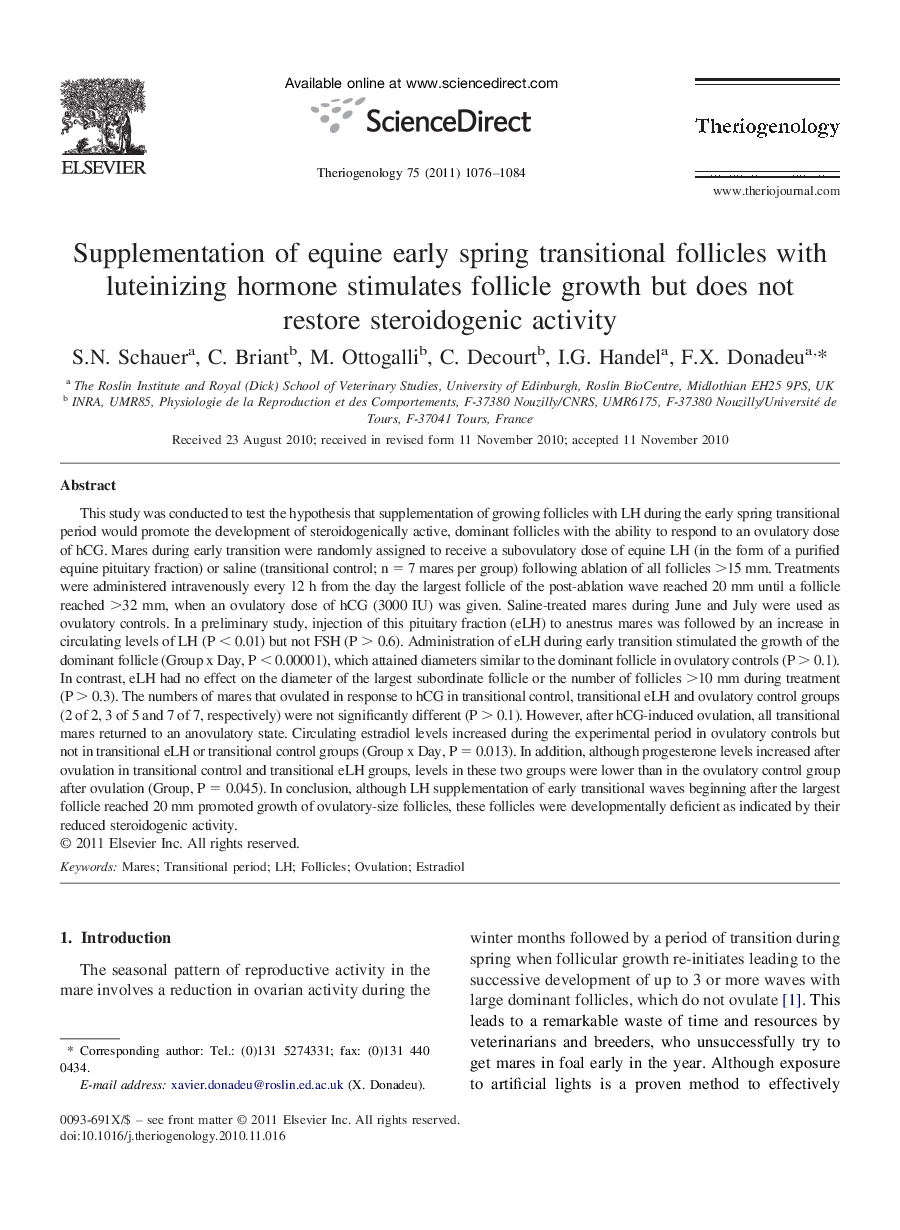| کد مقاله | کد نشریه | سال انتشار | مقاله انگلیسی | نسخه تمام متن |
|---|---|---|---|---|
| 10893117 | 1082147 | 2011 | 9 صفحه PDF | دانلود رایگان |
عنوان انگلیسی مقاله ISI
Supplementation of equine early spring transitional follicles with luteinizing hormone stimulates follicle growth but does not restore steroidogenic activity
دانلود مقاله + سفارش ترجمه
دانلود مقاله ISI انگلیسی
رایگان برای ایرانیان
موضوعات مرتبط
علوم زیستی و بیوفناوری
علوم کشاورزی و بیولوژیک
علوم دامی و جانورشناسی
پیش نمایش صفحه اول مقاله

چکیده انگلیسی
This study was conducted to test the hypothesis that supplementation of growing follicles with LH during the early spring transitional period would promote the development of steroidogenically active, dominant follicles with the ability to respond to an ovulatory dose of hCG. Mares during early transition were randomly assigned to receive a subovulatory dose of equine LH (in the form of a purified equine pituitary fraction) or saline (transitional control; n = 7 mares per group) following ablation of all follicles >15 mm. Treatments were administered intravenously every 12 h from the day the largest follicle of the post-ablation wave reached 20 mm until a follicle reached >32 mm, when an ovulatory dose of hCG (3000 IU) was given. Saline-treated mares during June and July were used as ovulatory controls. In a preliminary study, injection of this pituitary fraction (eLH) to anestrus mares was followed by an increase in circulating levels of LH (P < 0.01) but not FSH (P > 0.6). Administration of eLH during early transition stimulated the growth of the dominant follicle (Group x Day, P < 0.00001), which attained diameters similar to the dominant follicle in ovulatory controls (P > 0.1). In contrast, eLH had no effect on the diameter of the largest subordinate follicle or the number of follicles >10 mm during treatment (P > 0.3). The numbers of mares that ovulated in response to hCG in transitional control, transitional eLH and ovulatory control groups (2 of 2, 3 of 5 and 7 of 7, respectively) were not significantly different (P > 0.1). However, after hCG-induced ovulation, all transitional mares returned to an anovulatory state. Circulating estradiol levels increased during the experimental period in ovulatory controls but not in transitional eLH or transitional control groups (Group x Day, P = 0.013). In addition, although progesterone levels increased after ovulation in transitional control and transitional eLH groups, levels in these two groups were lower than in the ovulatory control group after ovulation (Group, P = 0.045). In conclusion, although LH supplementation of early transitional waves beginning after the largest follicle reached 20 mm promoted growth of ovulatory-size follicles, these follicles were developmentally deficient as indicated by their reduced steroidogenic activity.
ناشر
Database: Elsevier - ScienceDirect (ساینس دایرکت)
Journal: Theriogenology - Volume 75, Issue 6, 1 April 2011, Pages 1076-1084
Journal: Theriogenology - Volume 75, Issue 6, 1 April 2011, Pages 1076-1084
نویسندگان
S.N. Schauer, C. Briant, M. Ottogalli, C. Decourt, I.G. Handel, F.X. Donadeu,